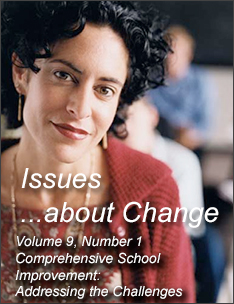Comprehensive School Improvement: Addressing the Challenges
Introduction
The report of the 1996 National Commission on Teaching and America's Future bore a strong message regarding the need for educational change: School transformation cannot succeed unless it focuses  on creating conditions in which teachers can teach and teach well. This report, coupled with current nationwide interest in encouraging schools to adopt comprehensive reform strategies or programs, urgently communicates the need for school improvement.
on creating conditions in which teachers can teach and teach well. This report, coupled with current nationwide interest in encouraging schools to adopt comprehensive reform strategies or programs, urgently communicates the need for school improvement.
Such reform may not be much to ask of schools that are already supported by adequate funding, continuous professional development programs, and active parent involvement. Many schools don't fit that picture however, and are crying out for help. It is with these schools, the ones that are struggling to meet the needs of their students, that SEDL has engaged in the Facilitating Implementation of Reform Strategies and Tactics (FIRST) project. The goals of this paper are to provide a deeper understanding of how schools experience comprehensive reform and to identify the issues that affect schools' efforts at improvement.
Taking a DIfferent Approach
This project took a systemwide look at comprehensive school improvement while simultaneously working with schools that were undertaking reform efforts. For the purposes of this work, "comprehensive school improvement" is an inclusive term for engaging an entire school staff in an in-depth study of the teaching and learning process. Emphasis is placed on the examination of all aspects of the school — curriculum, instruction, assessment, classroom management, professional development, parental and community involvement, school management, and so on—and identification of how all of these parts can work together to improve student results.
SEDL formed in-depth partnerships with five schools, one in each state of the educational laboratory's diverse service region. These partnerships were intended to differ from former models of school improvement in three specific ways. First, the focus of attention and assistance was on the entire school program and all factors that have the potential to affect student learning. This work was in no way to be a "quick fix" to show a fast turnaround in standardized test scores. Rather, the intent was to develop the capacity of school personnel and to promote their engagement in continuous improvement.
Second, the existing and proposed structures and practices at each school site were examined in terms of their expected benefits for student learning. Each school's needs were viewed as individual and unique, which required the creation of a program tailored to that specific site and a process to address specific areas of need.
Third, multiple technical assistance providers were coordinated to assist in the improvement efforts at each site during the FIRST project, and also beyond that time, to enable staff to stay informed and current in their practice. Again, because of the individual needs of each school site, the providers and the assistance that they offered varied.
Developing Alliances with Schools
Similarities existed among the schools in that each entered the partnership acknowledging that it was at risk of failing to meet the learning needs of its students, and each lacked experiences in school change. More important, staff at the five sites expressed their interest and commitment to the partnership as a means of producing meaningful changes in their schools and positively affecting student results.

Together, the sites displayed characteristics that are symptomatic of the challenges in public education across the nation — achievement scores were consistently low or falling, students were unhappy and/or unmotivated, parents were ignored, community members were disengaged, and school staff did not believe they could affect student learning.
The sites varied in terms of geography and demographics (race, ethnicity, socioeconomic status, students' cultural background), as well as in their capacity for reform planning and implementation.
Next Page: What We Are Learning

